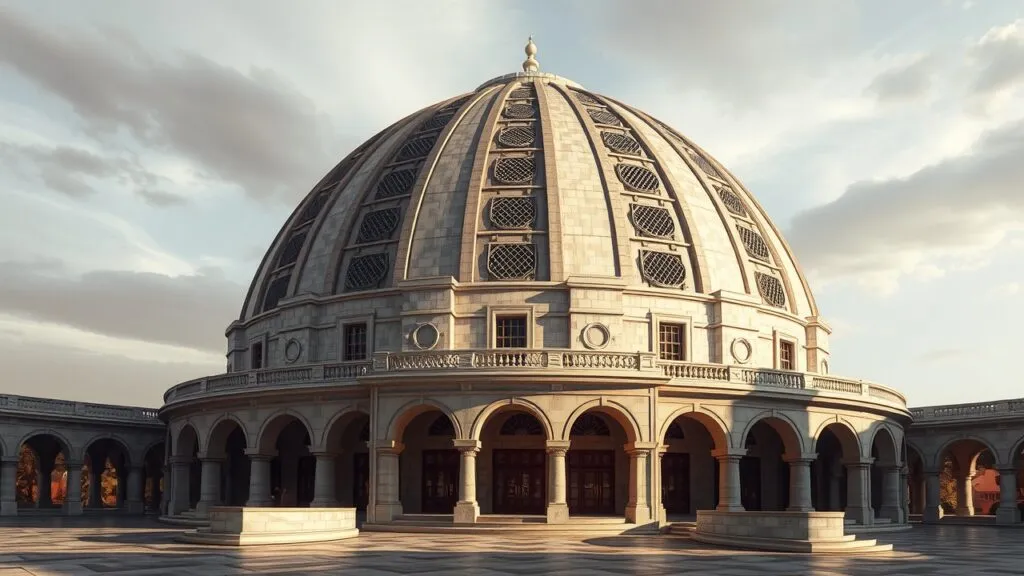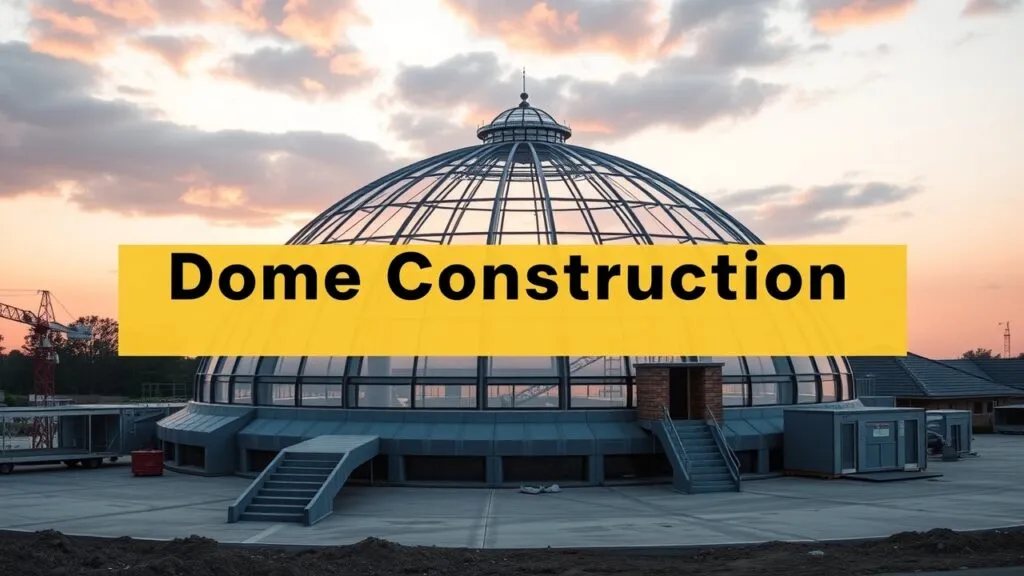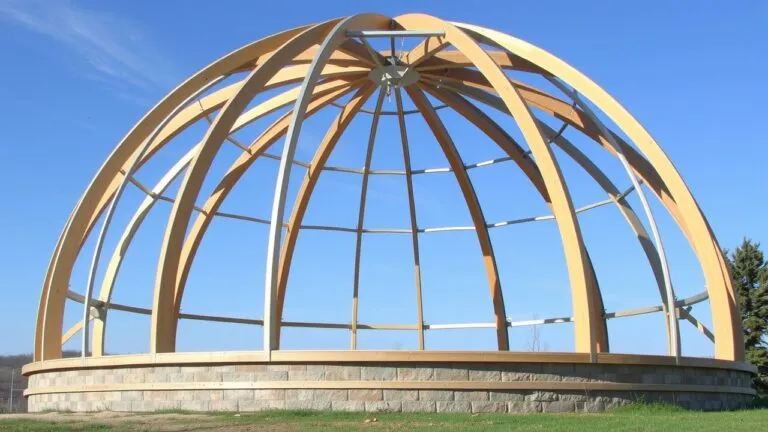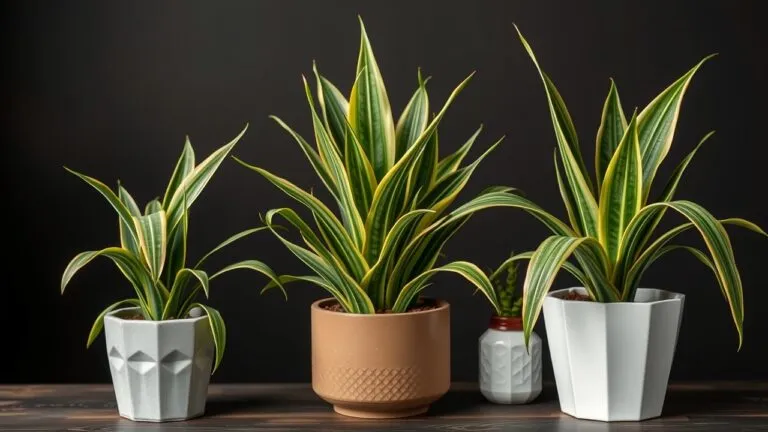Types of domes vary widely in design and application. This guide covers different dome structures, including geodesic and spherical domes, used in building and architectural projects.
What Is a Dome in Architecture?

A dome is a round, curved structure on top of a building. Dome architecture is important because it adds strength and creates large open spaces inside without many supports. This unique feature has made domes popular in different architectural styles throughout history.
Overview of Dome Shapes
Dome structures come in various shapes:
- Hemispherical Domes: These are half-spheres and are very common. They spread weight evenly, which makes them strong.
- Spherical Domes: These domes are fully rounded. They look nice and create spacious interiors, often found in religious buildings.
- Polygonal Domes: These have flat sides that create a polygon shape when viewed from below. They may not be as common but can add unique style to modern buildings.
Importance of Domes in Architectural History and Modern Construction
Domes have a rich history in architecture. From ancient Roman temples like the Pantheon to today’s sports arenas, domes symbolize creativity and importance. In modern construction, architects value domes for their energy efficiency and ability to let natural air flow inside. This design helps reduce the amount of material needed compared to standard rectangular buildings.
Why Are Domes Popular in Construction?
Domes have several key advantages that make them popular:
Structural Advantages
One major benefit of dome structures is their load distribution. The curve allows forces like gravity to spread evenly across the surface. This design increases strength while using less material, making it both cost-effective and eco-friendly.
Also, domed roofs help with energy efficiency by improving airflow inside the spaces below them. The natural flow of air helps keep temperatures comfortable without heavy reliance on heating or cooling systems.
Aesthetic Appeal Across Cultures
Domes also bring beauty that connects different cultures and eras. Their unique shapes inspire feelings of harmony, which is why they appear in many religious buildings around the world—like Islamic mosques with beautiful minarets and Christian cathedrals featuring grand cupolas.
In summary, understanding dome architecture shows its functional benefits as well as its significant historical role as an enduring symbol across diverse cultures.
Types of Domes Explained
Hemispherical Domes – The Classic Half-Sphere Design
Hemispherical domes are among the most well-known dome shapes. They look like a smooth half-sphere and are both beautiful and practical. The curved surface helps spread weight evenly, making the structure strong.
These architectural domes have deep roots in history, especially in Roman architecture. A great example is the Pantheon in Rome. It features a large oculus at the top, which lets natural light in and helps with air flow. Another famous example is Hagia Sophia in Istanbul, known for its stunning mosaics and vast dome.
Today, hemispherical domes are used in many places. You can find them in monuments, observatories, and other buildings. Their ability to handle weather conditions while providing roomy interiors makes them very popular.
Geodesic Domes – Strong Yet Lightweight Designs
Geodesic domes take a modern twist on dome construction. They focus on strength and lightness by using triangles. This design became popular thanks to Buckminster Fuller in the 20th century. By connecting triangles, geodesic domes can cover large spaces without needing support beams.
The basic idea behind geodesic construction makes these structures light but strong. This approach is great for sustainable building practices too! You often see modern domes in greenhouses because they’re energy efficient and allow good air flow. They are also found in event spaces and homes where a unique look is desired.
Buckminster Fuller’s ideas changed how we think about geometry and building design. His work shows that smart shapes can save materials while still being sturdy.
Onion Domes – Cultural Icons with Distinctive Shapes
Onion domes have a unique shape that stands out in religious architecture worldwide. These bulbous designs taper upwards, resembling an onion bulb—hence their name. They not only add beauty but also hold cultural meaning.
Famous examples include St Basil’s Cathedral in Moscow and many mosques that feature similar styles throughout Islamic architecture. These onion-shaped roofs help shed rainwater efficiently while allowing for more space inside.
These structures reflect local traditions and building techniques that have evolved over many years. Each dome tells its own story about culture and art through its unique design.
Ribbed Domes
Ribbed domes have a special framework. This framework includes ribs or arches that support the dome’s surface. This design boosts strength and helps distribute loads evenly. Because of this, ribbed domes can cover large areas without losing stability. Plus, they look impressive.
Many cultures have used ribbed designs in their buildings. For instance, Gothic cathedrals in Europe used ribbed vaults. These vaults not only added beauty but also let builders create taller structures with big windows. Similarly, mosques in Islamic architecture often feature ribbed domes for spacious prayer areas.
The benefits of ribbed domes are clear. They are visually appealing and efficiently cover large spaces. However, there are some challenges too. They may need more upkeep because water can collect on the ribs, and building them can be more complicated than simpler dome types.
Barrel Vaults
A barrel vault is like a tunnel made by extending a simple curve along a length. It looks like a series of arches connected together, which links directly to dome shapes through its curved form.
Barrel vaults have been part of architecture for centuries. They appear in important buildings such as Roman aqueducts and Renaissance churches. Famous examples include St. Peter’s Basilica in Vatican City and many ancient Roman basilicas where barrel vaulting added both strength and beauty to large interior spaces.
Other Notable Dome Types
Compound Domes
Compound domes mix different geometric shapes, like hemispheres and cones. These combinations allow for unique designs in modern buildings that blend style with functionality.
Monolithic Domes
Monolithic domes are made from one solid layer instead of multiple parts joined together. This approach is energy-efficient since it reduces heat loss common in regular building methods. They’ve been successfully used in eco-friendly housing projects around the globe, like Earth-sheltered homes designed for minimal environmental impact.
Inflatable Domes
Inflatable domes use modern materials to create temporary structures that can serve various purposes, such as event venues or emergency shelters during disasters. They’re quick to set up and very versatile.
Umbrella Domes
Umbrella-shaped structures often show up in stadiums or public places where sound quality is key alongside appearance; their design helps distribute sound well while providing ample space for large crowds beneath.
Oval Domes
Oval-shaped designs bring some unique engineering challenges compared to standard round ones because their shape needs careful weight distribution along the curve to stay stable even when heavy loads press down from above!
Materials and Construction Techniques for Domes
When building a dome, picking the right materials and methods is super important. The materials used affect how strong, energy-efficient, and lasting the dome will be.
Concrete Domes
Concrete domes are famous for their strength and long lifespan. They can handle a lot of weight because of their high compressive strength. Plus, concrete is tough against bad weather.
But there are some downsides too. Cracks can appear when temperatures change or if the ground settles. Also, because concrete is heavy, it might need extra support during construction.
For building methods, there are two main types: traditional pouring and modern precast options. Traditional pouring means mixing concrete on-site and putting it into molds. Precast options allow parts to be made off-site first and then brought together later. This can make the building process faster while keeping the structure strong.
Steel Domes
Steel domes are often used in places like stadiums and factories. They are lightweight yet very strong, which is a big plus. When treated properly, steel does not rust easily, which helps it last longer than some other materials.
However, steel conducts heat well. This means careful insulation is needed to keep buildings energy-efficient.
Wooden Domes
Wooden domes look nice and can be made sustainably. Good choices for wood include cedar or laminated wood because they hold up well in different conditions.
For building, people often use glulam beams (which are glued together) or regular timber framing methods. Using responsibly sourced wood cuts down on carbon footprints too, making these projects more eco-friendly.
Fabric Domes
Fabric domes offer cool solutions for temporary setups like sports events or festivals. Inflatable designs make quick setups easy without losing stability when stretched over sturdy frames made from materials like PVC or nylon.
These tensile structures serve practical purposes while also being visually appealing due to their sleek looks—great for modern designs!
Other Materials
Glass-fiber-reinforced concrete (GFRC) is another interesting material for domes! GFRC combines glass fibers with cement to create lightweight yet strong parts. It’s great for applications like skylights or decorations in larger dome projects since it allows light through while still being solid.
Knowing about different dome materials and construction techniques helps builders and engineers choose what works best for each project while keeping safety in mind!
Choosing the Right Dome: Factors and Considerations
When picking a dome structure, you have to think about different factors. Knowing these can help you choose the right dome for your project, whether it’s for a home, a business, or something else.
Budget
Budget is super important when planning dome construction. The costs of building a dome can change a lot based on its design, size, materials, and where it’s built. Here are some things to think about regarding your budget:
- Dome Construction Costs: Different types of domes cost different amounts because of their complexity and what materials are used.
- Cost Estimators for Domes: You can use cost estimation tools to see potential expenses for labor and materials.
- Financial Planning for Dome Projects: Make sure to set aside money not just for building but also for future maintenance.
Knowing these financial details will help keep your project on track and within budget.
Intended Use
What you plan to do with the dome really shapes its design and function. There are many types of domes that fit different purposes:
- Residential Domes: Smaller structures meant for homes or guest houses.
- Commercial Domes: Bigger spaces that work well for businesses like shops or offices with open floor plans.
- Industrial Domes: Used in places like warehouses where large, open areas are needed.
- Religious Buildings with Domes: Many churches or temples use domed designs to create inspiring spaces.
Choosing a dome based on its intended use makes sure it meets all necessary functions effectively.
Size and Scale
The size of the dome affects both how it looks and how strong it is:
- Impact on Structural Design of Domes: Bigger domes need stronger support systems because of their weight.
- Large vs Small Domes: Large structures provide ample space for gatherings, while smaller ones can be more cost-effective and easier to build.
Make sure size fits with both practical needs and site limits during planning.
Climate and Environment
The climate greatly affects what materials you should choose for dome construction:
- Material Selection for Different Climates in Dome Construction: For example, insulated materials work better in colder areas, while reflective surfaces can help in warmer climates.
- Energy Efficiency of Domes in Various Environments: Well-designed domed buildings can save energy by using natural ventilation that suits local weather conditions.
Thinking about climate helps improve performance throughout the year while cutting down energy costs.
Aesthetic Preferences
Aesthetics play a big role when deciding between different architectural styles:
- Matching Architectural Context with Dome Styles: Picking a style that fits well with nearby buildings improves the overall look of neighborhoods.
- Dome Aesthetics Across Cultures: Different cultures have unique styles; knowing these differences can enhance your appreciation for global architecture.
Your personal taste along with what’s around leads to satisfying designs that look good and work well!
Step-by-Step Decision Making Guide
Making choices about which type suits best involves organized steps like this checklist:
- Define Purpose – What activities will take place inside?
- Assess Budget – How much money do you have available?
- Evaluate Site Conditions – Check out land features like soil strength and zoning laws?
- Research Types Available– Look at options from geodesic shapes to traditional hemispherical forms?
By addressing each factor using this decision-making process, you’ll make smart choices leading to successful projects!
Comparison of Different Dome Types
| Type | Materials Used | Strength | Cost Range | Applications | Key Benefits | Challenges |
|---|---|---|---|---|---|---|
| Hemispherical | Concrete/Stone | High | High | Monuments/Historical Sites | Durable/Timeless Design | Heavy material requirements |
| Geodesic | Steel/Wood/Fabric | Very High | Moderate | Greenhouses/Event Spaces | Strong & Lightweight | Precision-dependent assembly |
| Onion | Stone/Brick | Moderate | Moderate | Religious Buildings | Visually Iconic | Maintenance Complexity |
| Monolithic | Reinforced Concrete | Extremely High | Variable Costs* | Sustainable Housing | Energy Efficient Construction | Specialized Construction |
Additional Considerations
Understanding the various types of domes helps builders and designers choose wisely. Each dome has special features that shape its design, construction methods, and uses. The materials in dome structures matter too, as they affect strength and cost.
The table above shows the main differences between several dome types. For example, hemispherical domes are usually made from concrete or stone, giving them durability but also making them heavy. On the other hand, geodesic domes use lighter materials like steel or fabric. This makes them easy to transport and assemble while still being very strong.
Onion-shaped domes are often seen in religious buildings because they look unique. But these may need more upkeep than others. Monolithic domes are great for energy savings and being eco-friendly, though they require special building techniques.
Choosing the right dome type is about balancing looks with practical needs like material choice and what it’s used for. As technology gets better, we might see cool new designs that make these famous structures even more functional and beautiful. Future changes could mean using more sustainable materials and better engineering to improve performance in different settings.
Best Practices

Best Practices for Dome Construction
Dome construction needs careful planning. One method to make sure the structure is strong is triangulation. This technique spreads weight evenly, which helps keep the dome stable. It reduces stress points, making it perfect for different dome types.
Choosing materials is super important in dome engineering. Builders should think about things like climate, earthquakes, and wind when picking materials. Common choices are concrete, steel, wood, and fabric. Each material has its own qualities that affect how long it lasts and how energy-efficient it is.
Safety during construction can’t be ignored. Workers must be trained on lifting heavy items and using equipment properly. Following safety rules specific to dome structures helps prevent accidents.
Maintaining and Repairing Domes
Keeping up with regular maintenance can help domes last longer. It’s smart to do routine checks to catch problems like leaks or cracks early. Cleaning the surfaces often prevents mold and keeps weather damage at bay.
Different types of domes can face similar problems over time. Issues like condensation buildup or weak structures can occur. Solutions may include using sealants or adding extra support without ruining the look of the dome.
For repairs, cost-effective methods are helpful. Using recycled materials when possible can save money, and DIY fixes are great if you have the skills. These ways keep quality high while keeping expenses low.
Future Trends in Dome Technology
New technologies could change how we build domes in exciting ways! 3D printing is one example; it allows designers more freedom while also cutting down waste from traditional building methods.
Smart homes with automated systems inside dome structures are becoming popular too! These innovations help save energy by adjusting settings based on how people use them over time.
Sustainability continues to be important as builders look for eco-friendly materials that reduce their carbon footprints. Many are moving away from non-renewable resources and opting for greener choices instead!
Frequently Asked Questions About Dome Structures
What are the key advantages of dome structures?
Dome structures offer superior load distribution. Their curved shape allows weight to spread evenly. This design enhances stability and reduces material use.
How does energy efficiency play a role in domes?
Domes improve energy efficiency through natural ventilation. Their shape promotes airflow, reducing heating and cooling costs. Sustainable building practices often incorporate domes for this reason.
What materials are commonly used for dome construction?
Common materials include concrete, steel, and wood. Fabric domes utilize flexible materials for temporary structures. Advanced options include glass-fiber-reinforced concrete and laminated wood.
How do different dome types impact interior space?
Dome shapes create spacious interiors with minimal supports. Hemispherical and geodesic domes provide expansive areas suitable for various applications, from homes to event spaces.
What are some historical examples of famous domes?
Notable examples include the Pantheon in Rome and St. Basil’s Cathedral in Moscow. These structures showcase diverse architectural styles throughout history.
Unique Insights into Dome Construction
- Types of Dome Designs: Various designs cater to specific needs, such as residential, commercial, or industrial uses.
- Dome Support Structures: Pendentives and arches enhance stability in dome constructions.
- Dome Strength and Stability: Proper calculations ensure that a dome can withstand loads from snow, wind, or seismic activity.
- Environmental Impact of Domes: Sustainable practices minimize the carbon footprint of dome construction.
- Applications of Domes: Domes serve various functions, including greenhouses, observatories, stadiums, and emergency shelters.
- Dome Maintenance Considerations: Regular inspections help prevent leaks and structural issues over time.
- Dome Innovations: New technologies like 3D printing may revolutionize future dome designs.
- Acoustic Design in Domes: Special considerations improve sound projection for theaters or arenas.
These points cover remaining keywords while aligning with the main topic of types of domes.
Related Topics
- types of dome construction
- types of dome materials
- types of dome designs
- types of dome structures
- types of dome shapes
- types of architectural domes
- types of dome support structures



Types of Domes: A Complete Guide to Dome Structures & Designs